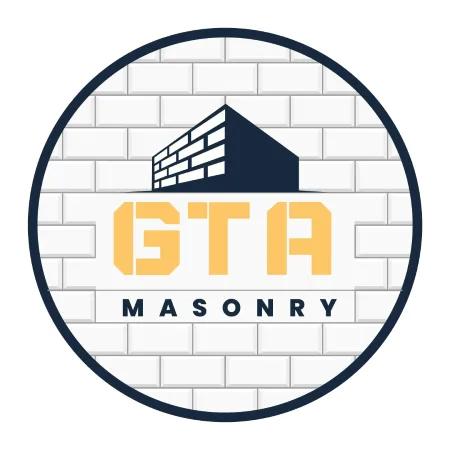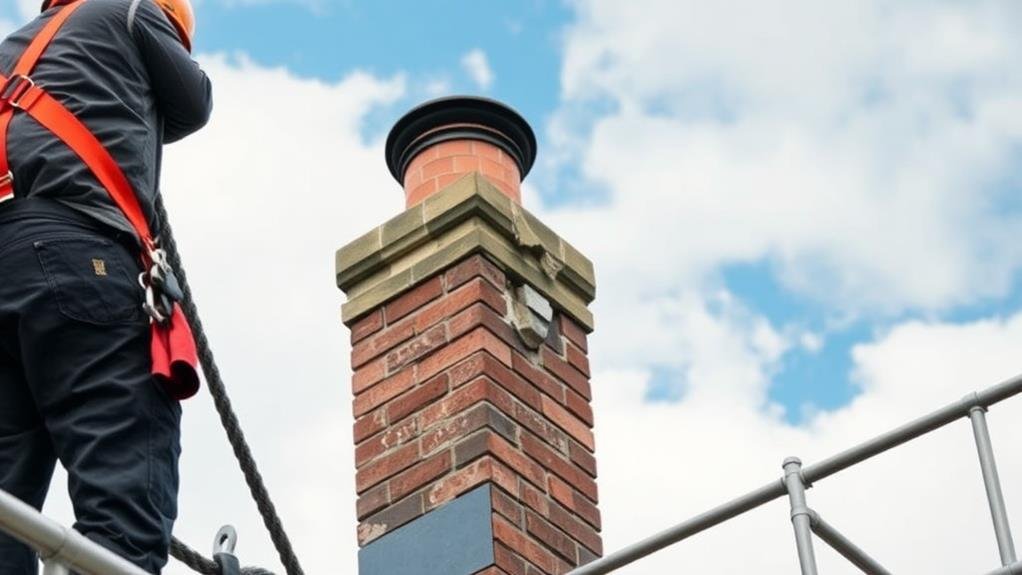To repair a leaking chimney in Richmond Hill, Ontario, you’ll need to identify the source of the leak, often related to damaged flashing, cracked crowns, or deteriorated mortar joints. Inspect your chimney for signs of damage, such as water stains, bubbling paint, or rusted metal components. Consider hiring a professional chimney service to guarantee accurate diagnosis and effective repair. They’ll assess the chimney’s structure, including the flashing and cap, to pinpoint the leak source. By addressing these issues promptly, you’ll prevent further damage and guarantee a safer, more efficient chimney. Next, we’ll explore the steps to inspect and repair specific chimney components.
Identifying Chimney Leak Sources
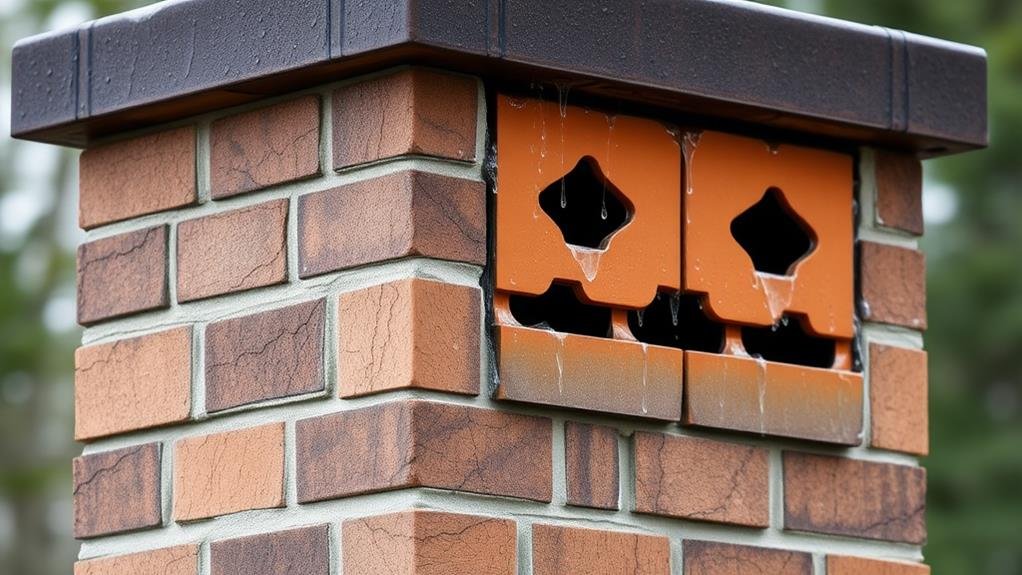
Detecting the Invisible Threat: Identifying Chimney Leak Sources
You mightn’t notice a chimney leak immediately, but the consequences can be severe. Water stains on your ceilings or walls, bubbling paint, and rusted metal components around the chimney are clear indicators that something is wrong.
Regular inspections can help identify early signs of leaks, such as discoloration or wet spots around the chimney’s base or on the roof. These visual cues are vital in catching the problem before it escalates.
Common sources of chimney leaks include damaged flashing, cracked chimney crowns, and deteriorated mortar joints, which can compromise the entire structure.
Another potential issue is soot or creosote buildup in the chimney, suggesting blockages that can lead to water retention and leaks.
Professional assessments are essential for diagnosing complex leak sources, as they often require specialized knowledge and tools to accurately pinpoint the issue.
Early detection and repair can save you from more costly and extensive repairs down the line.
Inspecting Chimney Crown Damage
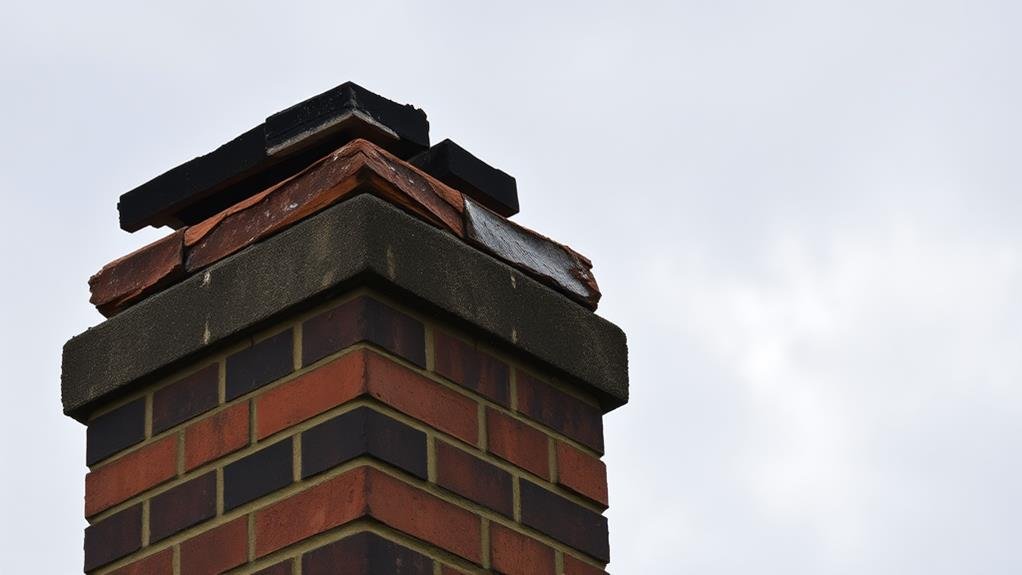
When it comes to safeguarding your chimney, inspecting the chimney crown is a vital step. The crown, which is the top part of the chimney, protects the flue and the chimney structure from water damage. Any cracks, chips, or missing sections can lead to leaks and cause significant structural damage.
Regular inspections are important, especially after severe weather events, to identify potential damage early and prevent costly repairs. Look for signs of deterioration such as cracks, gaps, or crumbling mortar. If you notice any issues, it’s imperative to address them promptly to prevent water from infiltrating the chimney and causing further damage.
A damaged chimney crown can lead to spalling of bricks and mortar on the chimney’s exterior due to freeze-thaw cycles. By inspecting the crown regularly, you can catch problems before they escalate.
For thorough inspections and repairs, consider hiring professional chimney services in Richmond Hill to guarantee the chimney crown is watertight and functioning properly. Early detection and repair can save you from more extensive and expensive repairs down the line.
Repairing Chimney Flashing Issues
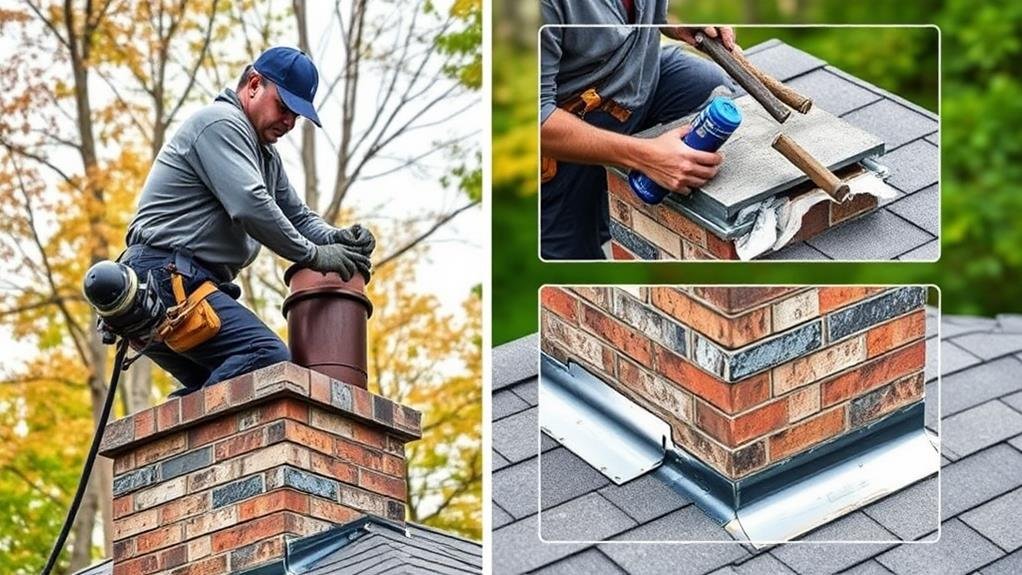
After guaranteeing your chimney crown is in good condition, it’s equally important to inspect the chimney flashing. The flashing acts as a protective barrier between the chimney and the roof, and improper installation or deterioration can lead to leaks and water damage.
You need to be vigilant for common signs of flashing issues, such as water stains on ceilings, rust on metal components, and mold growth around the chimney area.
To address flashing problems, you typically need to reseal or replace the flashing materials. This task should be conducted by certified professionals to guarantee a proper fit and seal.
Regular inspections of chimney flashing are essential, particularly after severe weather events, to catch any potential leaks before they escalate into serious damage.
Promptly addressing flashing issues can prevent costly repairs to both the chimney and roof, as well as protect the overall integrity of the home. Guarantee that these inspections and repairs are done by professionals to maintain safety and prevent further damage.
Sealing Chimney Cracks and Gaps
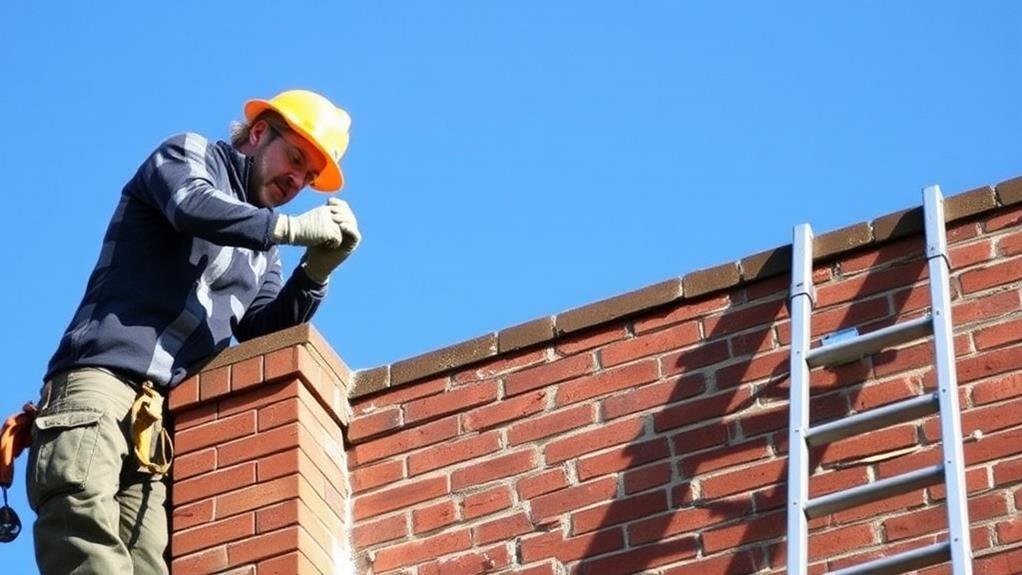
Sealing chimney cracks and gaps is an imperative step in maintaining a safe and efficient chimney system. You need to take proactive measures to prevent water intrusion, which can cause significant structural damage and costly repairs.
To effectively seal these cracks and gaps, utilize a high-quality sealant specifically designed for masonry. This will fill and waterproof any identified cracks or gaps in the chimney structure.
Regular inspections are vital to identify cracks early, guaranteeing timely sealing before they worsen and lead to leaks or moisture damage.
It’s important to focus on professional sealing of fuel channels to prevent smoke leakage and maintain proper ventilation, enhancing both safety and efficiency.
Consulting with certified chimney professionals for thorough assessments and sealing services guarantees long-lasting results. They’ve the expertise to handle various chimney issues, providing you with peace of mind knowing your chimney system is secure and functioning correctly.
Early detection and proper sealing guarantee the longevity and integrity of your chimney.
Rebuilding a Damaged Chimney
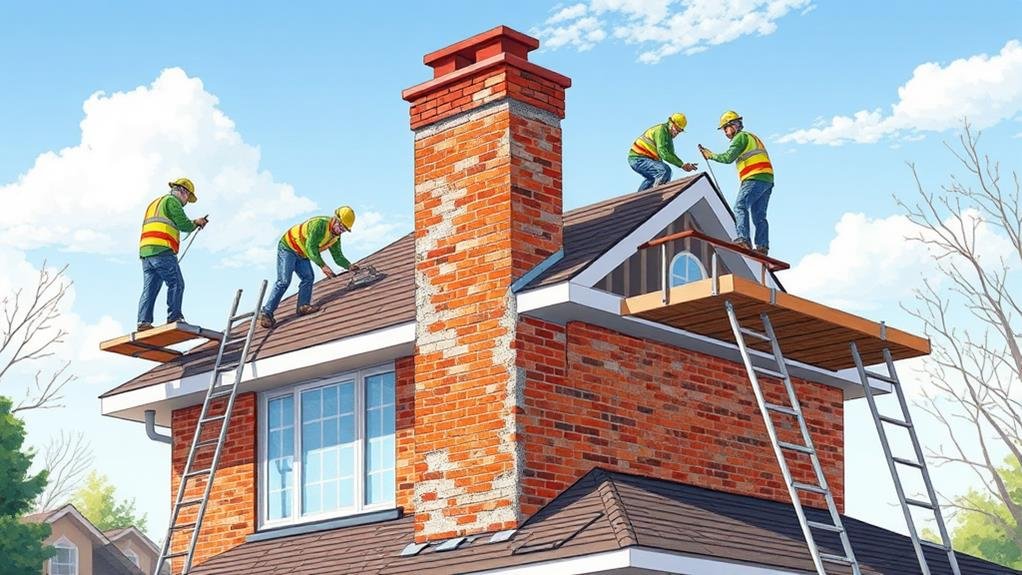
A thorough examination of your chimney’s structural integrity is the first step in rebuilding a damaged chimney. This extensive inspection helps identify issues that need addressing, guaranteeing a solid foundation for the new construction.
Professional chimney rebuilds aren’t only about aesthetics; they also enhance ventilation efficiency, leading to cleaner air quality and improved energy efficiency for your home.
Rebuilding a chimney typically starts at $449, a worthwhile investment for maintaining home safety and value. By utilizing proprietary methods and custom mortar mixtures during the rebuild, you can greatly reduce the risk of future cracks and erosion, extending the lifespan of your chimney.
A full rebuild eliminates the need for frequent repairs, providing you with long-term peace of mind and a reliable heating system.
The process begins with inspecting for and repairing any structural issues. Custom materials and techniques are then used to rebuild the chimney, assuring it’s both durable and functional.
This investment not only improves the appearance of your home but also guarantees the chimney operates efficiently and safely.
Preventing Future Leaks
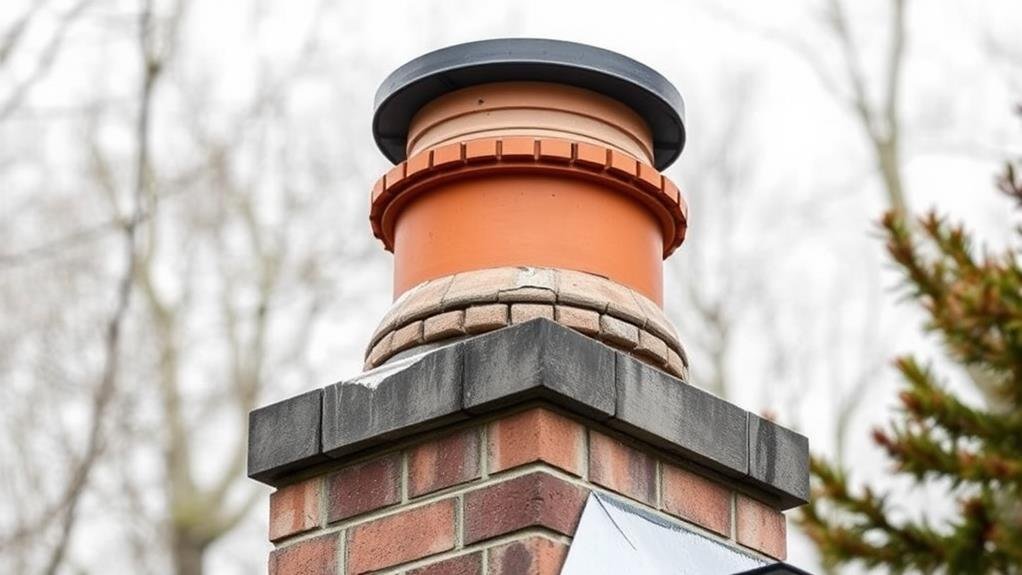
Preventing future leaks in your chimney requires proactive maintenance and regular inspections. By taking these steps, you can markedly reduce the risk of water damage and costly repairs.
Start by inspecting your chimney structure, including the flashing and cap, to identify any potential leak sources before they become major issues. Proper sealing of mortar joints through tuckpointing is also essential to prevent moisture intrusion, a common cause of chimney leaks.
Installing a high-quality chimney cap can block rainwater and debris from entering the flue, reducing the risk of leaks and water damage.
Additionally, maintaining clean and clear gutters and downspouts helps direct water away from the chimney area, minimizing the chances of water pooling around the base and causing leaks.
Finally, using waterproofing sealants designed for masonry can protect the chimney from water penetration while allowing it to breathe, preventing future leaks caused by trapped moisture.
Regular inspections and maintenance are key to keeping your chimney safe and functional.
Frequently Asked Questions
How to Repair a Water Leak Around a Chimney?
To repair a water leak around a chimney, you’ll need to inspect and potentially replace the chimney flashing, check for deteriorated mortar joints, and guarantee the chimney cap is properly installed and sealed to prevent rainwater intrusion.
How Do You Waterproof a Leaking Chimney?
To waterproof a leaking chimney, you’ll need to apply a high-quality waterproof sealant specifically designed for masonry surfaces, repair or replace the chimney crown if damaged, and guarantee a proper chimney cap is installed.
Can the Inside of a Chimney Be Repaired?
You can repair the inside of a chimney by addressing issues like cracked flue tiles. Specialized techniques, such as relining with stainless steel or aluminum, can restore functionality and safety to your chimney’s interior.
How Do You Cover a Leaky Chimney?
To cover a leaky chimney, you’ll inspect the chimney for cracks or gaps, apply a waterproof sealant to the exterior, consider installing a chimney cap, and guarantee the flashing is properly installed and sealed around the base.
In Closing
Repairing a leaking chimney in Richmond Hill, Ontario, demands prompt and precise action to guarantee safety and structural integrity. By identifying the source of the leak, inspecting and repairing chimney crown damage, fixing flashing issues, sealing cracks, and rebuilding damaged sections, you can restore your chimney to its best condition. Regular maintenance and inspections are vital to prevent future leaks. With the right guidance and tools, you can confidently address chimney leaks and secure a safer home.
